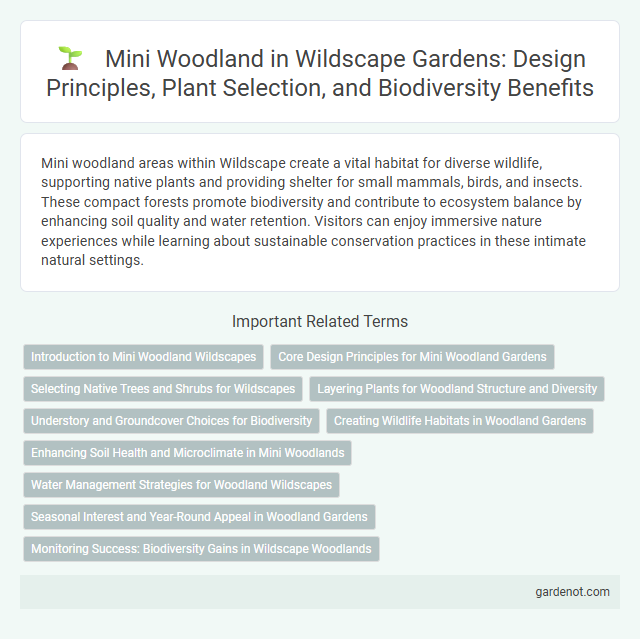Mini woodland areas within Wildscape create a vital habitat for diverse wildlife, supporting native plants and providing shelter for small mammals, birds, and insects. These compact forests promote biodiversity and contribute to ecosystem balance by enhancing soil quality and water retention. Visitors can enjoy immersive nature experiences while learning about sustainable conservation practices in these intimate natural settings.
Introduction to Mini Woodland Wildscapes
Mini Woodland Wildscapes create vibrant, compact ecosystems designed to support biodiversity in limited spaces. These microhabitats incorporate native trees, shrubs, and ground covers to attract pollinators, birds, and small mammals, enhancing urban and suburban environments. Strategic layering of plant species optimizes ecological benefits while requiring minimal maintenance.
Core Design Principles for Mini Woodland Gardens
Mini woodland gardens prioritize layered planting to mimic natural forest structures, enhancing biodiversity and visual depth. Emphasis on native shade-tolerant species supports local wildlife and ensures sustainable growth. Incorporating organic mulch and naturalistic pathways fosters soil health and creates immersive, tranquil environments within compact spaces.
Selecting Native Trees and Shrubs for Wildscapes
Selecting native trees and shrubs such as oak, hawthorn, and holly promotes biodiversity and supports local wildlife in mini woodland wildscapes. These species provide essential habitats, food sources, and shelter for birds, insects, and small mammals, enhancing ecosystem resilience. Planting a mix of native flora ensures seasonal interest and strengthens natural ecological connections within the wildscape.
Layering Plants for Woodland Structure and Diversity
Layering plants in a mini woodland enhances structural complexity and biodiversity by creating multiple vegetation strata, including ground covers, shrubs, and canopy trees. This technique supports diverse wildlife habitats, promotes nutrient cycling, and improves soil stability within the Wildscape environment. Selecting native species like ferns, dogwoods, and shade-tolerant wildflowers maximizes ecological benefits and natural woodland aesthetics.
Understory and Groundcover Choices for Biodiversity
Selecting diverse understory plants such as ferns, native shrubs, and shade-tolerant perennials enhances habitat complexity in mini woodlands, supporting pollinators and small mammals. Groundcover choices like wildflowers, mosses, and native grasses improve soil health and provide essential foraging areas for insects and amphibians. Incorporating a variety of native species ensures seasonal resource availability and promotes overall biodiversity in wildscape environments.
Creating Wildlife Habitats in Woodland Gardens
Mini woodland gardens offer an effective solution for creating wildlife habitats by incorporating native trees, shrubs, and ground cover that provide food, shelter, and breeding grounds for local species. Designing layered vegetation mimics natural woodland ecosystems, supporting biodiversity and attracting birds, insects, and small mammals. Incorporating features such as logs, leaf litter, and water sources enhances habitat complexity, fostering a thriving mini woodland environment.
Enhancing Soil Health and Microclimate in Mini Woodlands
Mini woodlands enhance soil health by promoting diverse microbial activity and increasing organic matter through leaf litter and root systems. These ecosystems create a stable microclimate by regulating temperature and moisture levels, reducing soil erosion and supporting nutrient cycling. The improved microhabitat fosters biodiversity, encouraging the presence of beneficial insects and microorganisms essential for sustainable woodland growth.
Water Management Strategies for Woodland Wildscapes
Mini woodland wildscapes implement water management strategies such as rainwater harvesting, permeable ground covers, and native plant selection to optimize water retention and reduce runoff. Incorporating swales and rain gardens enhances groundwater recharge while preventing soil erosion and nutrient loss. These methods maintain ecosystem health and support diverse flora and fauna within the woodland habitat.
Seasonal Interest and Year-Round Appeal in Woodland Gardens
Mini woodlands offer vibrant seasonal interest with spring blossoms of bluebells and wild garlic, summer foliage providing dense shade and habitat, and autumn's fiery hues of maples and oaks enhancing year-round appeal. Evergreen species like holly and yew maintain structure and greenery during winter months, supporting wildlife and visual interest even in colder seasons. The dynamic mix of deciduous and evergreen plants ensures continuous ecological benefits and aesthetic value throughout the year in woodland gardens.
Monitoring Success: Biodiversity Gains in Wildscape Woodlands
Wildscape woodlands showcase a notable increase in biodiversity through rigorous monitoring of species presence and habitat quality. Data from mini woodland areas reveal rising populations of native flora and fauna, indicating successful ecosystem restoration efforts. Continuous assessment of indicator species and habitat conditions ensures adaptive management strategies that sustain biodiversity gains.
Mini woodland Infographic

 gardenot.com
gardenot.com